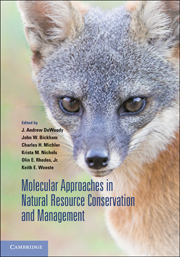Book contents
- Frontmatter
- Contents
- Contributors
- Preface
- 1 Biodiversity discovery and its importance to conservation
- 2 Gene flow, biodiversity, and genetically modified crops: Weedy rice in Thailand
- 3 A community and ecosystem genetics approach to conservation biology and management
- 4 Vertebrate sex-determining genes and their potential utility in conservation, with particular emphasis on fishes
- 5 Historical and contemporary dynamics of adaptive differentiation in European oaks
- 6 Association genetics, population genomics, and conservation: Revealing the genes underlying adaptation in natural populations of plants and animals
- 7 Hybridization in threatened and endangered animal taxa: Implications for conservation and management of biodiversity
- 8 Pollen and seed movement in disturbed tropical landscapes
- 9 Implications of landscape alteration for the conservation of genetic diversity of endangered species
- 10 Integrating evolutionary considerations into recovery planning for Pacific salmon
- 11 Using molecular methods to improve the genetic management of captive breeding programs for threatened species
- 12 Wildlife reintroductions: The conceptual development and application of theory
- 13 Evolutionary toxicology
- Index
- Plates
- References
4 - Vertebrate sex-determining genes and their potential utility in conservation, with particular emphasis on fishes
Published online by Cambridge University Press: 05 July 2014
- Frontmatter
- Contents
- Contributors
- Preface
- 1 Biodiversity discovery and its importance to conservation
- 2 Gene flow, biodiversity, and genetically modified crops: Weedy rice in Thailand
- 3 A community and ecosystem genetics approach to conservation biology and management
- 4 Vertebrate sex-determining genes and their potential utility in conservation, with particular emphasis on fishes
- 5 Historical and contemporary dynamics of adaptive differentiation in European oaks
- 6 Association genetics, population genomics, and conservation: Revealing the genes underlying adaptation in natural populations of plants and animals
- 7 Hybridization in threatened and endangered animal taxa: Implications for conservation and management of biodiversity
- 8 Pollen and seed movement in disturbed tropical landscapes
- 9 Implications of landscape alteration for the conservation of genetic diversity of endangered species
- 10 Integrating evolutionary considerations into recovery planning for Pacific salmon
- 11 Using molecular methods to improve the genetic management of captive breeding programs for threatened species
- 12 Wildlife reintroductions: The conceptual development and application of theory
- 13 Evolutionary toxicology
- Index
- Plates
- References
Summary
GENETIC MARKERS IN WILDLIFE CONSERVATION
Individual identification
Often, animals leave clues that can provide some information about their individual identities. These may be conventional fingerprints, which are extremely useful in courts of law but can be physically altered or removed and are restricted to humans. In contrast, deoxyribonucleic acid (DNA) fingerprinting (Avise 2004) is important not only in human forensics and paternity analysis but also in conservation biology and resource management (Table 4–1). When monitoring DNA fingerprints, biologists are capitalizing on the permanent genetic tags by which nature has labeled each individual. In principle, DNA fingerprints (e.g., from leaves, root tips, blood, hair, or feathers) can be traced over space and time, thereby yielding insights into organismal behavior, population structure, and population demography.
Sexing assays and conservation
In concert with individual identification via DNA fingerprinting, molecular sexing has proven valuable in conservation and management (see Box 4 by Lisette Waits). Molecular assays that distinguish males from females can be informative in many ways. For example, the sexes of most dioecious plants are indistinguishable prior to sexual maturity, yet molecular assays have revealed that sex ratios change as seeds develop into reproductively mature plants (Korpelainen 2002; Korpelainen & Kostamo 2008). For vertebrates, most efforts in molecular sexing have focused on mammals and birds in part because of the special interest in these animals, but also because the mode of sex determination is known and conserved within each of these two taxonomic groups. Thus, reliable molecular-sexing assays have been relatively straightforward to develop and also to transfer across species within each group.
- Type
- Chapter
- Information
- Publisher: Cambridge University PressPrint publication year: 2010
References
- 2
- Cited by



